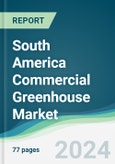The South American commercial greenhouse market is projected to expand at a CAGR of 4.90% to reach a market size of US$471.951 million in 2029 from an initial value of US$337.578 million in 2022.
High-performance benefits provided by commercial greenhouses in terms of long-term cost saving, providing controlled temperature, and automation potential to enhance the overall crop productivity coupled with the growing emphasis on technological innovations in crop production is driving the demand for such technology in South America. Furthermore, the growing flower and ornamental production opportunities in major South American nations namely Brazil have further paved the way for future market growth. According to the Brazilian Institute of Floriculture, in 2021, the Brazilian flower market witnessed 15$ growth with revenue reaching up to R$10.9 billion which signifies a 13.5% increase over 2020’s revenue.
Booming fruit and vegetable production propels the South American commercial greenhouse market.
Commercial greenhouses optimize light distribution, and energy efficiency and provide a controlled climate to grow fruits and vegetables even in the off-season. Rapid population and bolstering food consumption have increased the overall food demand in South America which has accelerated fruit and vegetable production in the major SA nations. For instance, according to the USDA’s “Fresh Deciduous Fruit Annual” report issued in November 2023, Argentina’s commercial apple production stood at 4,55,000 metric tons in January 2023. This marks a 6.55% increase over January 2022’s production scale of 4,27,000 metric tons. Furthermore, as per the same source, the deciduous fruit production in Argentina is anticipated to reach 4,86,850 metric tons for the marketing year 2023/2024. Moreover, various initiatives and strategic collaboration between universities and market players are acting as additional driving factors. For instance, Hydroponics System International shares well-established commercial relations with Brazilian University to educate Brazilian students regarding the best protected-cultivating techniques for tomato production using a hydroponic gutter system.
It is projected that the South American commercial greenhouse market in Brazil will grow steadily.
The commercial greenhouse market in Brazil has experienced significant growth in recent years, driven by various factors that reflect the country's evolving agricultural landscape. One key factor contributing to this growth is the increasing demand for year-round production of high-value crops. Commercial greenhouses provide a controlled environment that allows farmers to overcome the limitations of traditional outdoor farming. It enables them to cultivate crops irrespective of seasonal variations. Brazil's vast and diverse geography exposes its agricultural sector to different climatic conditions, and commercial greenhouses offer a solution to mitigate these challenges. These controlled environments help farmers maintain optimal temperature, humidity, and light levels, creating a conducive atmosphere for the consistent and efficient growth of crops. As a result, the adoption of greenhouse technology has become a strategic choice for many farmers seeking to enhance productivity and ensure a stable and diversified income.
Moreover. the increase in Brazil's agriculture industry's value-added activities serves as a significant growth driver for the commercial greenhouse market. As the agricultural sector adds value to its products through processing, packaging, and marketing, there is a growing demand for consistent and high-quality produce throughout the year. Commercial greenhouses play a pivotal role in meeting this demand by providing a controlled environment that ensures optimal conditions for crop cultivation, resulting in enhanced yields and improved product quality. The value-added aspect of Brazil's agriculture industry amplifies the need for reliable and efficient methods of production, and commercial greenhouses offer a solution to achieve year-round, controlled cultivation. It also positions commercial greenhouses as a crucial component in supporting the broader goals of increased farm output. Furthermore, this increased emphasis on value addition in agriculture drives the expansion of the commercial greenhouse market.
The growing awareness of sustainable farming practices and the need to reduce the environmental impact of agriculture has also fueled the expansion of the commercial greenhouse market in Brazil. Greenhouses enable more efficient use of resources such as water and fertilizers, leading to higher yields with lower environmental footprints. This alignment with sustainable agricultural practices has attracted both government support and private investments, further propelling the greenhouse market growth.
Government initiatives and policies have played a crucial role in supporting the adoption of greenhouse technology in Brazil. Incentives, subsidies, and favourable regulations have encouraged farmers to invest in modern agricultural practices, including the establishment of commercial greenhouses. These policy measures aim to boost food production, ensure food security, and create a more resilient agricultural sector and sustainable agricultural sector in Brazil.
Segmentation:
By Type:
- Freestanding
- Gutter-Connected
By Equipment:
- Heating System
- Cooling System
- Control System
- Others
By Application:
- Fruits and Vegetables
- Flowers and Ornamentals
- Nursery Crops
By Country:
- Brazil
- Argentina
- Others
Table of Contents
Companies Mentioned
- Netafim
- Zanatta Agricultural Greenhouse
- Hydroponics System International
- LettUs Grow Ltd
Methodology

LOADING...
Table Information
| Report Attribute | Details |
|---|---|
| No. of Pages | 77 |
| Published | February 2024 |
| Forecast Period | 2022 - 2029 |
| Estimated Market Value ( USD | $ 337.58 Million |
| Forecasted Market Value ( USD | $ 471.95 Million |
| Compound Annual Growth Rate | 4.9% |
| No. of Companies Mentioned | 4 |









